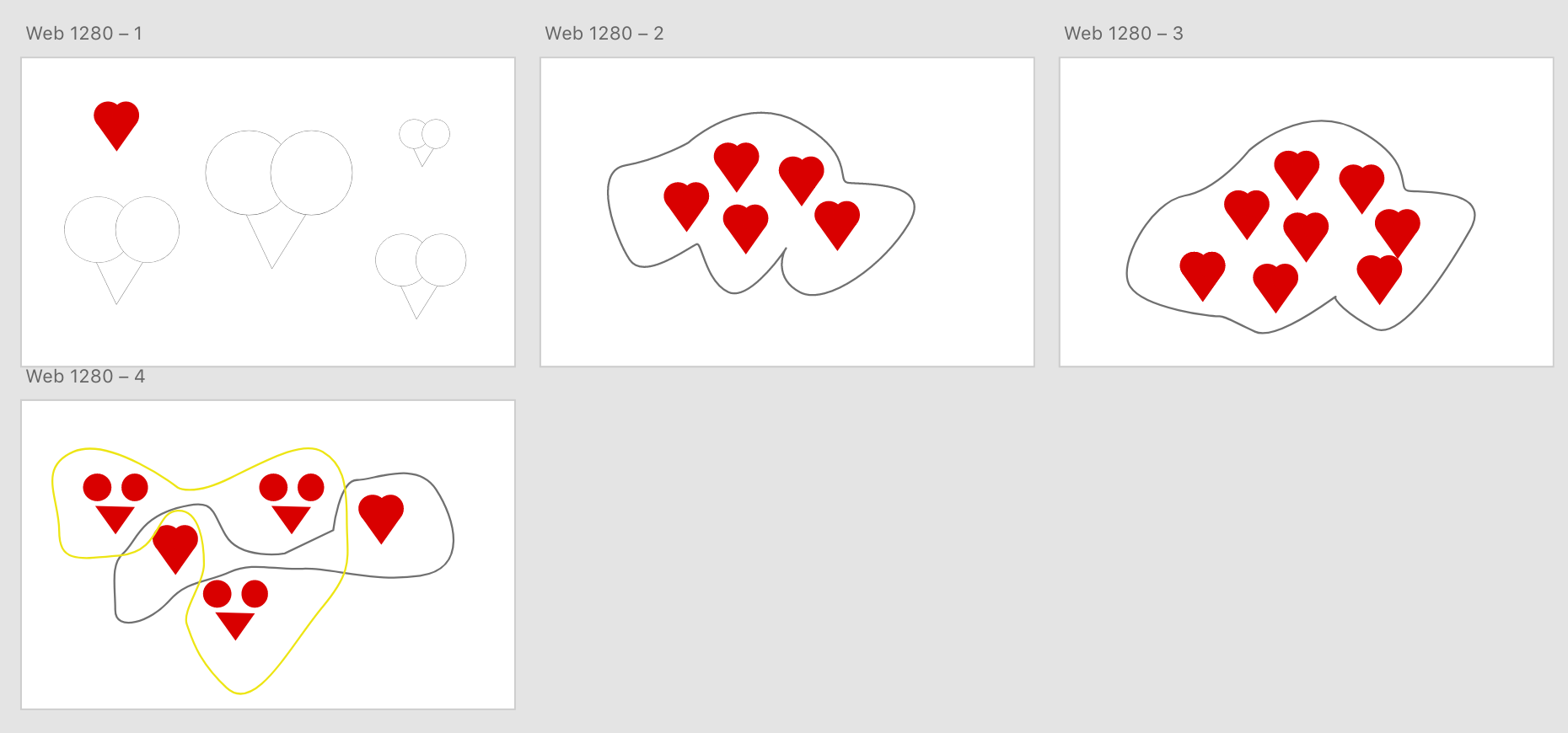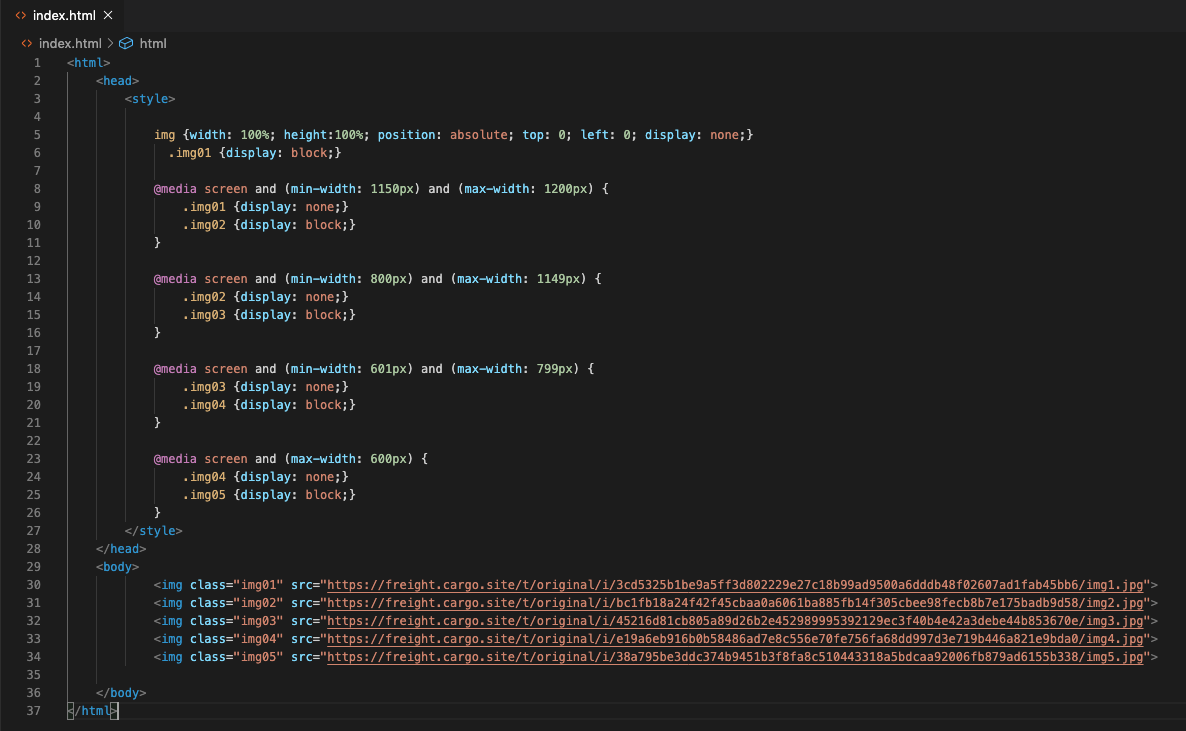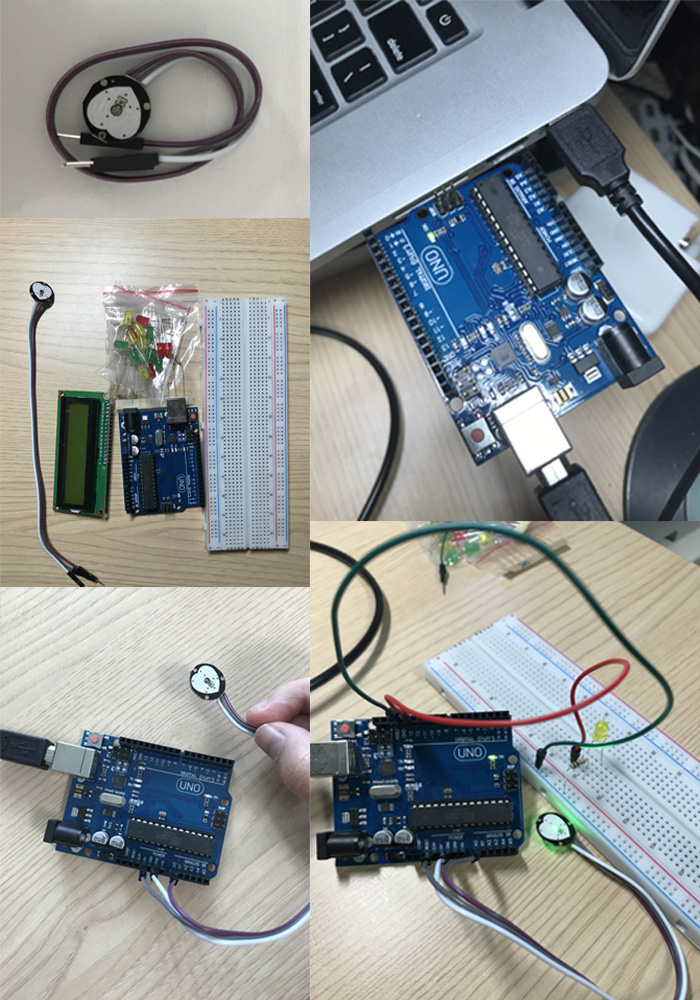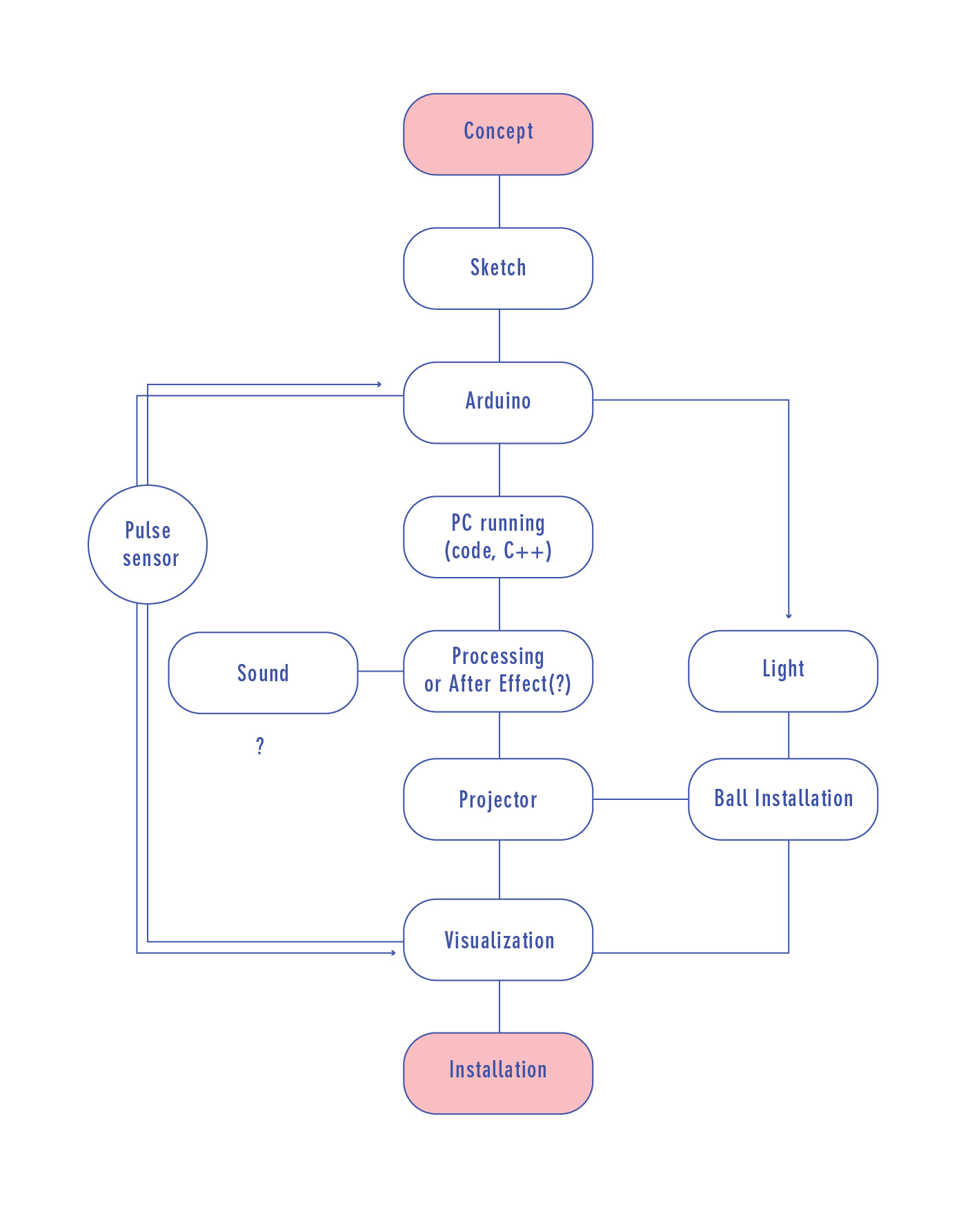Week 13
GLSL Shader workshop
Our mission was to create a composition that incorporates sound using GLSL shader. The sound must be considered and “go with” the visuals. So I've decided to use songs that have color metaphors in it and showing the beat and colors that goes with the song.Purple Haze by Jimi Hendrix
Wings by SoYoon Whang
Week 10-12
Digital ecologies
I've always thought sensing pulse could be an interesting way of seeing (knowing) our mind because pulse and heartbeat have a lot to do with our feelings. So by getting data(numbers) from my own pulse (body) I wanted to explore the idea of digitalizing what's unseen and unrevealed (our state of mind). So by using my pulse data as a part of the digital ecology system I created a potable pulse sensing wrist. With the device, I also wanted to see if it creates any meaningful data changes and communicate with my teammate's device remotely.


Group work

concept sketch

final graphic
Our final outcome was a web page that can interact with each other's variable datas. Graphic elements move around based on each other's data so we named it "Parasite" to point out that our data rely on each other.
Final webpage: https://shiny-niu-wu.github.io/parasite/
Webpage: Shiny, illust elements: NaYoung
Reading: "The Electronic as Post-optimal Object"
Quote 1"It shows that by taking a playful approach to package design and liberating it from product semantics, even the packaging of electronics can yield interesting results. Ironically, part of the critical success of this design, despite being a package, is its treatment as a thing rather than an image."
This quote was so interesting because it definitely made me think of the importance of looking at things in a different way. And for some reason, this idea of “liberating from a product semantics” reminds me of one of the most famous modern conceptual art “Fountain” by Marcel Duchamp. I still remember how shock I was after listening to the intention and the concept of this art piece. Just by changing its meaning and usage, the artist successfully made it possible for the audience to look at it in a different way. I think the success of design can be somewhat similar to this case.
Quote 2“ Dematerialization means different things depending on what it is defined in relation to: immaterial/material, invisible/visible, energy/matter, software/hardware, virtual/real. But the physical can never be completely dismissed: “Every symphony has its compact disc; every audio experience its loudspeaker; every visual image its camera and video disc. ”
This quote was very inspiring for me as it is closely related to what I’ve been always interested in which is visualizing (revealing) our mind. For a long time, I was interested in how our mind works and how we can utilize it usefully and as I was doing several projects in this class I also couldn’t help but thinking that everything in some way inevitably conveys physical form. So the quote “physical can never be completely dismissed” deeply resonated with me.
Quote 3“The most difficult challenges for designers of electronic objects now lie not in technical and semiotic functionality, where optimal levels of performance are already attainable, but in the realms of metaphysics, poetry, and aesthetics, where little research has been carried out:”
I agree with this statement. and it's also related to something I learned while working as a designer. Every time when I’m learning new skills, it gave me to think that skill is just another tool (channel) for conveying ideas although the tool itself can be very important too. I often felt what makes things more meaningful is the concept and intention which is very hard to be taught.
Reading: "Radical technologies"
Quote 1“Inevitably, some of these ambitions involve surveillance, security and control. But whatever the context in which these connected devices appear, what unites them is the inchoate terror that a single event anywhere might be allowed to transpire unobserved, uncaptured and unleveraged.”
This quote reminds me of some of the discussions we dealt with in Critical Worldview class. In this term, we talked a lot about how technology can be racist, discriminative, and biased. In this sense, I think we can't help but acknowledge the possible drawbacks that high technology might cause such as the invasion of privacy and personal data. It seems very likely and even inevitable in a way that the more advanced technology we have the less freedom we have.
Quote 2“One forum thread goes quite a bit further; entitled “Can You Quantify Inner Peace?,” it discusses metrics that the instrumented aspirant might use to measure their progress toward heights of consciousness previously understood as the preserve of Zen meditators and yogic adepts.”
The question “Can you Quantify Inner Peace?” Was especially intriguing because it was so closely related to my interests and my project I did in this class. There was this project called “meditation” that I got a lot of inspiration from. And what the artist did in this project was measuring audiences’ pulse rates and convert that into visual elements based on the numbers, which I think was a very clever way of showing quantify one’s inner peace. I believe there is a clear relationship between our mind and body and possibly in the future, there will be more potential that we can measure the mind through technology that we use everyday.
Quote 3“The philosopher Graham Harman reminds us that “we live in a world in which things withdraw from awareness, silently enabling our more explicit deeds.” But what he doesn’t mention is that very often some party is counting on that withdrawal because it serves their interests. It is not merely for reasons of philosophical curiosity that it is worth our while to haul these reticent things back into the light of day, and open them up for a more considered inspection.”
Although I do think that what the author argues is important I still believe that there are certain waves and trends that are irresistible. Especially in capitalism, I think it’s inevitable that there is always going to be some party getting benefit from those withdrawals. Giving light back sounds very idealistic for me.
Week 9
Reading: "Vehicle"
Quote 1“Get used to a way of thinking in which the hardware of the realization of an idea is much less important than the idea itself.”
I wonder If the author means is that the idea itself is more important than how it shows or represents. If it is I think this is an important aspect not just in the technology area but also in any other areas that are engaged with creation. For example, from the past art education I got, I dealt with many different materials (ceramic, glass, painting and so on) but what I learned the most crucial all the time was not what kind of material I had to use but what kind of concept I was trying to convey.
Quote 2“You cannot help admitting that Vehicle 3C has a system of VALUES, and, come to think of it, KNOWLEDGE, since some of the habits it has, like destroying light bulbs, may look quite knowledgeable, as if the vehicle knows that light bulbs tend to heat up the environment and consequently make it uncomfortable to live in.”
This description was very interesting to me because it made me think about the question that I have never asked myself which is what knowledge really means. Is it different from just knowing? How can we tell if one thing is knowledgeable or not? It also made me think about the term “smart” which is probably the most widely used when are we referring to technology devices. Can those two mean somewhat similar or not?
Quote 3“ You would almost be tempted to say: where decisions are being made, there must be a WILL to make them. Why not? For all we know, this is not the worst criterion for establishing the existence of free will.”
This quote made me think of the relationship between decision making and free will. Do we make decisions based on our pure free will? I was also a little confused about the very last sentence that is the author proposing, what does it exactly mean by “criterion” and “establishing” here?
Week 8
Project 3: Digital ecologies
Workshop 1Week 6 - 7
Reading: "What is code"
Quote 1“The average programmer is moderately diligent, capable of basic mathematics, has a working knowledge of one or more programming languages, and can communicate what he or she is doing to management and his or her peers. Given that a significant number of women work as journalists and editors, perform surgery, run companies, manage small businesses, and use spreadsheets, that a few even serve on the Supreme Court, and that we are no longer surprised to find women working as accountants, professors, statisticians, or project managers, it’s hard to imagine that they can’t write JavaScript. Programming, despite the hype and the self-serving fantasies of programmers the world over, isn’t the most intellectually demanding task imaginable. Which leads one to the inescapable conclusion: The problem with women in technology isn’t the women.”
The story of the woman in the IT field was quite intriguing for me, as I had never thought about gender issues in the field seriously before. I only vaguely imagined that the programming field can be somewhat male-centric but this statement really made me wonder why men are more likely to go into the IT field than women. Would there be any scientific reason why more men go into the IT field than women? (maybe the same question can be applied to why there are certain types of subjects or job fields where there is only one gender is dominating, is it something in our nature?) And the chart at the bottom of the section was also very provocative as it shows a steady growth of the ratio of men in the IT field whereas women are decreasing dramatically. The unequal distribution of people along the gender line might take its toll on the advancement of the field in general. I feel that it’s something we need to address for a fairer, equitable environment.
Quote 2“The industry twists and turns so often, though, that who knows what the next 10 or 20 years will bring? The iPhone, and mobile in general, created a brief renaissance for people who could program using lower-level languages such as Objective-C, people who could worry about a computer’s memory. Perhaps the Internet of Things will turn everything into a sensor. (Already you wander Disney World with a wristband, and it watches and tracks you; the whole place is a computer. Δ) This will require yet more low-level thinking. And then there will be websites to make, apps to build, and on and on.”
I can somewhat agree with this statement since everything changes so fast in the IT industry. I also sometimes wonder how the world might change in the next 10 or more years and what the role of the people in the IT industry might be in bringing about the dramatic transformations. It also reminds me of some of the concerns that my friends who are working as an engineer shared, namely that the fast-changing world makes it almost impossible for them to make any valid, educated predictions. I also wonder what “low-level thinking” has to do with IoT turning everything into a sensor at the last argument.
Quote 3“The greatest commercial insight of the technology industry is that if you control a computing environment, you can move the market. You can change the way people do things, the way they listen to music, watch videos, and respond to advertising. People who work at technology companies are supposed to take an idea and multiply it by a few million people, yielding a few billion dollars.”
It really rings true for me if we think about such examples as Youtube or Netflix. Those platforms literally revolutionized the way people consume media. About 10 years ago it was hard to imagine living without TV but now these days people spend more time watching videos from the internet. Also, it is possible for people to upload the videos they created, which highlights the interactive nature of the newly emerging platforms. There has been a report suggesting that the amount of time people spend on public broadcasting has been reduced, because of the popularity of other online platforms that provide much diverse content. This trend might continue and it’s exciting to think about what kind of technology will change the market in the future.
Week 5
Unity project: Worldbuilding / Simulation
Theme: spreading
Inspired by Coronavirus, Yayoi Kusama, and fireworks which all have somewhat spreading images,
I tried to express round objects are spreading all over the places.

spreading from Nayoung Kwon on Vimeo.
Art/design projects focusing on simulation
Brillo Box (Soap Pads) Andy WarholAndy Warhol’s Brillo Boxes are precise copies of commercial packaging. While they fulfill the idea that art should imitate life, they also raise questions about how we identify and value something as art. If Warhol transformed a mundane commercial product into a work of art, how did that transformation happen? Considering Warhol made numerous Brillo Boxes and sold them to art collectors and museums, his can also be considered mass-produced consumer goods.
Amazon Andreas gursky Youtube link ARedefining Photography | Andreas GurskyWonderland Wonderland (article) YeonDoo Jung
Week 4
Creative Kluging
1.code
2.Result: Responsive webpage
Concept: Initial aim was to connect sensor data to the webpage

reading "Experiments"
Quote 1“We learned quickly that exposed viewpoints are not good listening points, as they are contaminated by air and road traffic. But over the day we gathered a good collection of sounds for transmission.”
It seems as if a contrast is drawn between the places from which the sounds were collected, such as bird songs, water sounds, and animal sounds, and those “exposed viewpoints” where air and traffic pollution abounds. I was wondering how to define “exposed viewpoints” and what some of the examples are that fall into this category?
Quote 2“Our calls remained unanswered. People ignored the ringing phones, and if they did answer soon hung up. With several of our team observing the phone booths we were by now targeting directly, we realised that the phones were only answered when somebody was in the booth about to make a call anyway.”
The result of this experiment seems very alarming to me, prompting me to question what considerations had gone neglected in the preparation phases of the experiment. In other words, what could have been done differently in order for the experiment to go as the researchers expected? To be more specific, how can we effectively address, or alleviate, the psychological burden that insiders/informants/participants of the research study might feel?
Quote 3“Despite the almost complete failure of the test we were paradoxically enthused by the experience. … As an occasion for evaluation, the Digital Boudoir experiment was clearly a failure. But as an opportunity to advance our thinking, it was useful and even inspiring.”
I think that this quote represents a great lesson. Despite self-perceived failures, or maybe even because of those, we can always find something useful and inspiring. Maybe the value of the experiment is for gaining new insights and thinking from trials and errors.
Week 3
Diagram of "Meditation"

reading "What do Prototypes Prototype?"
Quote 12p
“What is significant is not what media or tools were are used to create them, but how they are used by a designer to explore or demonstrate some aspect of the future artifact.”
This gave me new insight about the concept of prototype, because it is normally considered that the prototype is defined as a prototype if and only if characterized by certain types of software tools. At the same time, I am concerned about the possibility of confusion that might arise due to conflicting perceptions of a prototype between a designer and a user. In other words, something that is conceived of as a prototype by a designer might not be perceived as such by users. How do we address such a disparity in perception?
Quote 25p
“In fact, these three prototypes were developed almost in parallel. They were built by different design team members during the early stages of the project. No single prototype could have represented the design of the future artifact at that time.”
This quote was interesting to me, because it directs attention to the fact that the role, the looks and feels, and the implementation of a prototype are not a sequential process. In fact, they can take place in parallel. My question is, is this the case in practice? How do we know that we think through various considerations simultaneously, rather than separately?
Quote 314p
“It was highly motivating to users to be able to manipulate real user data through a novel user interface, and much was learned about the design. However, the designers also felt that they had to invest a large amount of time in making the prototype, yet had only been able to support a very narrow role compared to the breadth shown in the animation shown in Example 8. Many broader design questions remained unanswered.”
This is the problem I feel about prototyping as a designer. Sometimes in order to make the prototyping process both efficient and effective, it takes too much time and effort that sometimes fail to lead us to successful results. This brings me to a question about ‘What is a prototype?’ I also wonder how detailed prototyping should be and how do we know what is enough in terms of the scope of a prototype?
Week 2
Eexamples of interactive installations
reading "Hacker hacked"
Quote 1"Hackers believe that essential lessons can be learned about the systems – about the world – from taking things apart, seeing how they work, and using this knowledge to create new and even more interesting things."
I think this is an important statement because it shows the author's point of view about hacker spirit, such as in what way hacker ethic is important and why should be valued.
Quote 2" It seems safe to say, though, that it’s not very hacker-like to aspire to conventional empowerment, to get a job at a blue-chip company while reading The Seven Habits of Highly Effective People. The hacker impulse is critical. It defies, for example, corporate ambitions."
It is an argument that can see the author has a more romantic view of hacker culture and that it's about freedom, understanding complex systems, and disregarding authority.
Quote 3" I’m going to stake a claim on the word though, and state that the true hacker spirit does not reside at Google, guided by profit targets. The hacker impulse should not just be about redesigning products, or creating ‘solutions’. A hack stripped of anti-conventional intent is not a hack at all. It’s just a piece of business innovation."
it seems a very bold and strong statement. The author says that "A hack stripped of anti-conventional intent is not a hack at all" and it brings me a question about what is "anti-conventional" really mean. Is anything that makes a profit and business-oriented ideas could be considered as an "anti-conventional"?
Week 1
less common creative technology tools
Blynk
Blynk is a hardware-agnostic IoT platform with white-label mobile apps, private clouds, device management, data analytics, and machine learning.
vvvv
vvvv is a general purpose toolkit with a special focus on real-time video synthesis and programming large media environments with physical interfaces, real-time motion graphics, audio and video. vvvv uses a dataflow approach and a visual programming interface for rapid prototyping and developing.
Pure Data
Pure Data (Pd) is a visual programming language developed by Miller Puckette in the 1990s for creating interactive computer music and multimedia works. While Puckette is the main author of the program, Pd is an open-source project with a large developer base working on new extensions.It is released under a license similar to the BSD license. It runs on GNU/Linux, Mac OS X, iOS, Android and Windows. Ports exist for FreeBSD and IRIX.
creative technology projects that inspire you conceptually or move you emotionally
One Hundred Live And Die
118 x 132 x 21 inch
Bruce Nauman Bruce Nauman – ‘The True Artist Helps the World’ | TateShots
ETERNAL RECURRENCE
SOGANG MEDIA LAB(Professor Moon-Ryul Jung)
reading "Critical Making"
Quote 1
"Critical making is less about the aesthetics and politics of design work
and focuses instead on making practices themselves as processes of material and conceptual exploration."
Since designers are usually obsessed with thinking about how to show, how it looks, the idea of how Critical Making is not the result but more about the process was very interesting. I also wonder about the possibility of viability or solution-oriented kind of aspect of these practices. and if this could be some form of speculative design practice.
Quote 2"However, by constructing their own PRM system and having to make decisions about how it might function, they not only felt that they increased their knowledge, but they also became more invested and in a sense responsible for the adoption and use of DRM.
This quote shows the value of Critical Making teaching method by showing actual examples. However, how could this kind of practice method being applied to other courses other than engineering? How open design tools can be helpful in this aspect?
Quote 3
"As a teaching and a research method, critical making is thus dependent on open design methods, tools and communities.To put it most simply, the expertise necessary to create prototypes and engage in processes of software and hardware construction must be open and available in order to allow for the kinds of critically engaged practices described above."